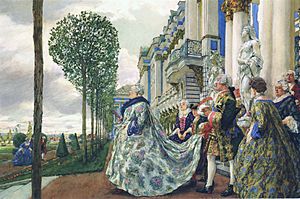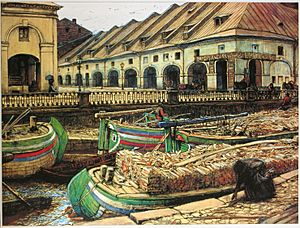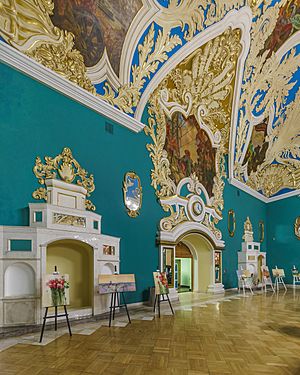Eugene Lanceray facts for kids
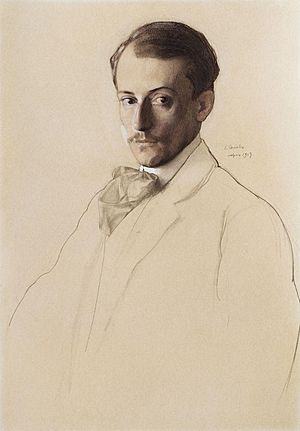
Yevgeny Yevgenyevich Lanceray (Russian: Евгений Евгеньевич Лансере; 4 September [O.S. 23 August] 1875 – 13 September 1946), also known as Eugene Lansere, was a talented Russian artist. He was a graphic artist, painter, sculptor, and illustrator. He also created mosaics. Lanceray was part of an art group called Mir iskusstva, which means "World of Art".
Contents
Early Life and Art School
Lanceray was born in Pavlovsk, a town near Saint Petersburg, Russia. He came from a very famous family of artists. His father, Eugeny Alexandrovich Lanceray, was a sculptor. His grandfather, Nicholas Benois, and his uncle, Leon Benois, were well-known architects. Another uncle, Alexandre Benois, was also a respected artist and art expert.
Yevgeny's sister, Zinaida Serebriakova, became a painter, and his brother Nikolay became an architect. Art was truly in their family!
Yevgeny's father passed away when Yevgeny was only eleven years old. However, his father's artistic work greatly influenced Yevgeny. Even as a grown-up artist, Yevgeny said that his interest in showing people's everyday actions and different cultures came from his father. His love for the Caucasus region also came from his father.
Yevgeny spent his childhood in Ukraine, on his father's small estate called Neskuchnoe. After his father died, his mother moved the family to St. Petersburg. They lived in his grandfather's house, which was famous among artists.
Lanceray started his art education in St. Petersburg. He studied at the Drawing School of the Imperial Society for the Encouragement of the Arts from 1892 to 1896. Later, he traveled to Paris, France, to continue his studies. He attended the Académie Colarossi and Académie Julian between 1896 and 1899.
Artistic Career Before the Revolution
After finishing his studies in France, Lanceray returned to Russia. He joined Mir iskusstva (World of Art), an important Russian art group. This group was formed in 1899 in Saint Petersburg and had its own art magazine. Other famous members included Lanceray's uncle Alexandre Benois, Konstantin Somov, and Léon Bakst.
Like other artists in Mir iskusstva, Lanceray loved the "Rococo" art style. This style was popular in the 1700s and was known for its fancy and playful designs. Lanceray often found ideas for his art in Russian history and art from the 1700s.
Yevgeny Lanceray was younger than the main artists of Mir iskusstva. He learned a lot from them, especially from his uncle Alexandre Benois. Lanceray's first important paintings and drawings were made around 1890-1900. At that time, he was most interested in painting historical scenes, especially landscapes with old buildings.
One of Lanceray's most famous mural paintings is on the ceiling of the Moscow Kazansky railway station. He created this large artwork between 1933 and 1934. He loved using tempera paint for his murals. But he worked with many different art forms, including painting, drawing, illustrating books, and designing theater sets. He first started working in theater in the early 1900s, like many other artists from the Mir iskusstva group.
Life After the Russian Revolution
Yevgeny Lanceray was one of the few famous Mir iskusstva artists who stayed in Russia after the Revolution of 1917. This revolution changed Russia a lot. His sister, Zinaida Serebriakova, moved to Paris in 1924 because the new government's ideas did not fit her art.
Lanceray left Saint Petersburg in 1917. He lived for three years in Dagestan, a region where he became very interested in "Oriental" (Eastern) art styles. His interest grew even more after trips to Japan and Ankara, Turkey, in the early 1920s.
In 1920, he moved to Tbilisi, Georgia. While in Georgia, he taught at the Tbilisi State Academy of Arts from 1922 to 1934. He also illustrated books, including stories about the Caucasus by Leo Tolstoy. One of his students was Apollon Kutateladze.
Lanceray left Georgia in 1934 and settled in Moscow. There, he worked on decorating the Moscow Kazansky railway station and the Hotel Moskva. During this time, he also continued to design sets for plays and shows.
Three years before he passed away, he received the Stalin Prize. In 1945, he was given the title of People's Artist of the RSFSR, which is a high honor for artists. He died in Moscow at 71 years old.
Moscow Kazansky Railway Station Murals
One of Lanceray's most famous works is the mural at the Kazansky Railway Station in Moscow. He worked on it from 1932 to 1934 and again from 1944 to 1946.
The famous Russian architect Alexey Shchusev was in charge of the station's design. In 1916, Shchusev, Alexandre Benois, Zinaida Serebriakova, and Lanceray were hired to plan the decorations for the station. However, the revolution stopped these plans.
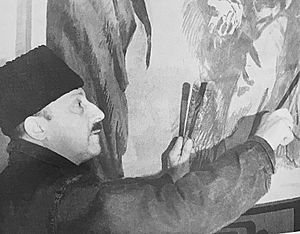
In 1932, the Soviet Union changed its approach to architecture. A grand, monumental style, known as 'Stalinist' architecture, became popular. Lanceray, who was an experienced artist with traditional ideas, was invited from Tbilisi to Moscow to continue working on the Central Railway Station's decorations. He was responsible for the restaurant area inside the station.
In his 1932-1934 paintings, Lanceray tried to show special features of each painted region. For example, the Murmansk mural shows a busy ship crew. The Crimea mural shows a smiling Tatar woman with a clear sky, exotic trees, and a working carpenter in the background.
Lanceray completed murals like Moscow Construction, Murmansk, and Crimea in the 1930s. In January 1934, after putting up the first painting, Crimea, Lanceray wrote that he was surprised by the effect. He felt it looked small and not as grand as he wanted. He realized how challenging it was to make large paintings look good from a distance, especially with the building's high ceilings and tricky lighting.
The artist preferred to paint on canvas, which was then attached to the ceiling. While Lanceray was sometimes disappointed with his technique, the government officials were not fully happy with the themes of his paintings. They felt his projects did not show enough "socialist" ideas and used too many abstract symbols.
Lanceray continued working on these large paintings even after World War II ended. After he died, other artists had to finish the work using his sketches. Today, the decorated ceiling of the Kazansky railway station looks very different. The Soviet-era paintings, mostly in brown colors, seem a bit lost among the fancy, gilded decorations.
This part of the building is now a special lounge for people with business class tickets. Every New Year's Eve, a stage is set up there for children's shows and music concerts.
Murals in Kharkiv, Ukraine
In 1932, Lanceray finished two large murals in the Zheleznodorozhnik Palace of Culture in Kharkiv, Ukraine. This building is now called the "Central House of Culture and Technology of the South Railway." One mural is named Partisans of the Caucasus salute the Red Army, and the other is Meeting of Komsomol members with the peasants of Crimea.
Over time, these paintings became damaged and were often covered. They were restored for the Euro-2012 event. These two murals are the only large artworks by Yevgeny Lanceray that are still in Ukraine. They are also rare examples of murals from the 1930s that still exist in Kharkiv. Many other wall paintings in Kharkiv were lost during the war, or disappeared during repairs, or were purposely removed.
After Ukraine passed a law called the Law of Decommunization in 2015, these murals by Lanceray were at risk of being removed. People discussed whether to keep them. Since the artworks did not directly promote communist ideas, officials asked the government to protect them as cultural heritage. If approved, these murals would be the first large paintings from that time that the Ukrainian government would protect.
See also
 In Spanish: Yevgueni Lanseré para niños
In Spanish: Yevgueni Lanseré para niños
- List of Russian artists
- Kasli iron sculpture


